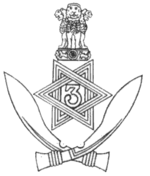3 Gorkha Rifles
| 3 Gorkha Rifles (1950 onwards) 3rd Queen Alexandra's Own Gurkha Rifles (1908-1950) |
|
|---|---|
 |
|
| Active | 1815 – Present |
| Country |
|
| Branch | Indian Army |
| Type | Rifles |
| Size | 5 Battalions |
| Regimental Centre | Varanasi, Uttar Pradesh |
| Motto(s) |
Kayar Hunu Bhanda Marnu Ramro "Better to die than live like a coward" |
| Colors | Green; faced black |
| March | War Cry:Jai Maha Kali, Ayo Gorkhali (Hail Goddess Kali, The Gorkhas are here) |
| Decorations | 2 Victoria Cross 1 Ashoka Chakra 1 Kirti Chakra 5 Vir Chakras 5 Shaurya Chakras 1 Yudh Seva Medal 19 Sena Medals 1 Bar to Sena Medal 4 Param Vishist Seva Medals 5 Ati Vishist Seva Medals 9 Vishist Seva Medals 2 McGregor Medals 26 Mentioned-in-Despatches 46 COAS' Commendation Cards 19 GOC-in-C's Commendation Cards |
| Battle honours |
Delhi 1857, Ahmad Khel, Afghanistan 1878–80 Burma 1885–87, Chitral Tirah Punjab Frontier First World War La Bassée 1914, Armentières 1914, Festubert 1914 '15, Givenchy 1914 Neuve Chapelle Aubers France and Flanders 1914–15 Egypt 1915–16 Gaza, El Mughar, Nebi Samwil Jerusalem Tell 'Asur, Megiddo Sharon Palestine 1917–18, Sharqat, Mesopotamia 1917–18, Afghanistan 1919 Second World War Deir el Shein North Africa 1940–43 Monte della Gorgace Il Castello Monte Farneto Monte Cavallo Italy 1943–45 Sittang 1942 Kyaukse 1942 Imphal Tuitum, Sakawng Shenam Pass, Bishenpur, Tengnoupal Meiktila Defence of Meiktila Rangoon Road, Pyawbwy Pegu 1945 Burma 1942–45 Post 1947 Uri, Jammu and Kashmir 1947–48 Shingo River Valley Jammu and Kashmir 1971 |
| Insignia | |
| Regimental Insignia | A pair of crossed khukris, with a star in-between and the numeral 3 within |
| Tartan | Colqhuon (pipes and drums) |
The 3 Gorkha Rifles is an Indian Army infantry regiment comprising Gurkha soldiers of Nepalese origin. It was originally a Gurkha regiment of the British Indian Army formed in 1815. They were present at a number of actions and wars including the Siege of Delhi in 1857 to the First and Second World Wars. After the Partition of India in 1947 the regiment was one of the six Gorkha regiments transferred to the Indian Army as part of the Tripartite Agreement signed between India, Nepal and Britain at the time of Indian independence. Prior to independence, the regiment was known as the 3rd Queen Alexandra's Own Gurkha Rifles. In 1950 the regiment's title was changed to 3 Gorkha Rifles. Since 1947 the regiment has participated in a number of conflicts including the 1947 and 1971 wars against Pakistan.
The regiment was raised during the Gurkha War by Sir Robert Colquhoun on 24 April 1815 as the Kemaoon Battalion. It did not consist entirely of Gurkhas but of men from Kumaon and Garhwal. The regiment adopted the tartan of the Clan Colquhoun.
The regiment was primarily used to police the border with Nepal, doing so for many decades until the Indian Mutiny began in 1857. The battalion was actively involved in the efforts to quell it. During the Siege of Delhi—which lasted from March to September 1857—the regiment, part of Colonel Colin Campbell's Third Column, took part in the storming of Kashmiri Gate and gained the Battle Honour "Delhi 1857". The mutiny was quelled by July 1858.
...
Wikipedia
